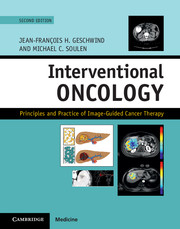Book contents
- Frontmatter
- Contents
- List of contributors
- Section I Principles of oncology
- 1 Interventional oncology: The fourth pillar of cancer care
- Section II Principles of image-guided therapies
- Section III Organ-specific cancers – primary liver cancers
- Section IV Organ-specific cancers – liver metastases
- Section V Organ-specific cancers – extrahepatic biliary cancer
- Section VI Organ-specific cancers – renal cell carcinoma
- Section VII Organ-specific cancers – chest
- Section VIII Organ-specific cancers – musculoskeletal
- Section IX Organ-specific cancers – prostate
- Section X Specialized interventional techniques in cancer care
- Index
1 - Interventional oncology: The fourth pillar of cancer care
from Section I - Principles of oncology
Published online by Cambridge University Press: 05 September 2016
- Frontmatter
- Contents
- List of contributors
- Section I Principles of oncology
- 1 Interventional oncology: The fourth pillar of cancer care
- Section II Principles of image-guided therapies
- Section III Organ-specific cancers – primary liver cancers
- Section IV Organ-specific cancers – liver metastases
- Section V Organ-specific cancers – extrahepatic biliary cancer
- Section VI Organ-specific cancers – renal cell carcinoma
- Section VII Organ-specific cancers – chest
- Section VIII Organ-specific cancers – musculoskeletal
- Section IX Organ-specific cancers – prostate
- Section X Specialized interventional techniques in cancer care
- Index
Summary
In the years since the first edition of this book, interventional oncology (IO) has continued to establish itself as an essential pillar within the firmament of multidisciplinary oncologic care, alongside medical, surgical, and radiation oncology. The perception of IO has evolved from ignorance or skepticism into something that is taken for granted by knowledgeable oncologists, who now refer patients with the expectation that we will counsel appropriate image-guided therapies to offer optimal benefit, and integrate that therapy into an oncologic care plan with our sister disciplines. This gratifying status is a result of years of effort to establish the credibility of our discipline. The path is now open to any practitioner of minimally invasive, image-guided therapy to build an IO practice.
Entry into an IO practice for an interventional radiologist starts with common services for cancer patients such as venous and enteral access, biopsies, and palliative procedures. These basic services, although poorly remunerated and demanding little or no longitudinal care outside of the interventional radiology (IR) suite, are the initial point of contact with cancer patients and their referring oncologist. Viewed as a free IO consultation, every biopsy, chest port, or paracentesis provides an opportunity to offer more sophisticated services to manage the patient's cancer, and to educate patients and fellow oncologists about the value of IO.
Establishing an IO practice requires an infrastructure common to all clinical practices – an office with examination rooms, staffed by receptionists, secretaries, medical assistants, nurses, nurse practitioners, physician assistants; an electronic medical record; and billing and pre-certification services. The number of support staff will equal or exceed the number of physicians. Yet this investment is essential to a robust and profitable practice. IO services are more remunerative than other IR services over the long run and will evolve to dominate group income. Downstream professional revenue per new IO consultation, including imaging as well as therapeutic services, is extremely high. Cancer has surpassed cardiovascular diseases and is now the leading cause of death worldwide. Given the increasing role of IO, growth in the field is guaranteed for the foreseeable future.
- Type
- Chapter
- Information
- Interventional OncologyPrinciples and Practice of Image-Guided Cancer Therapy, pp. 1 - 2Publisher: Cambridge University PressPrint publication year: 2016

